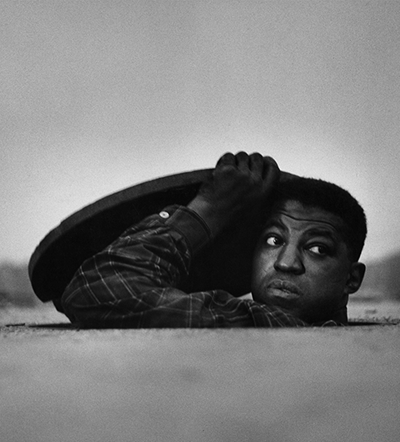
The Invisible Man, Harlem, New York, 1952. Gelatin silver print
“I am an invisible man,” begins Ralph Ellison’s famous 1952 novel, in an opening that rivals “Call me Ishmael” and “Lolita, light of my life” for its compact resonance. The narrator of Invisible Man goes on to say that he’s “not a spook like those that haunted Edgar Allan Poe; nor am I one of your Hollywood movie ectoplasms.” Instead, his invisibility is caused by race: being a black man in 1950s America makes him a blank canvas onto which people’s fears and anxieties are projected.
How do you photograph an invisible man? That was the challenge Gordon Parks took up in 1952, when Invisible Man was published. At that time, Parks himself was a highly visible black man. He’d broken through race barriers to become the first African-American staff photographer at Life magazine, and had written his own prose and poetry. He’d made an enduring and iconic portrait, American Gothic, in which a dignified cleaning woman symbolizes the shabby treatment of blacks in America.
The soulful images Parks produced, with inspiration from Ellison’s novel, are the subject of an intriguing exhibition, Contact: Gordon Parks, Ralph Ellison and ‘Invisible Man’ at the Howard Greenberg Gallery. At the time he made this work, Parks had just won a plum assignment to work in Paris for Life. He was leading a cosmopolitan life of glamor–but his passion and empathy for Harlem shines bright and clear in his Invisible Man series.




 Facebook
Facebook Permalink
Permalink Digg
Digg Reddit
Reddit LinkedIn
LinkedIn StumbleUpon
StumbleUpon Tumblr
Tumblr

